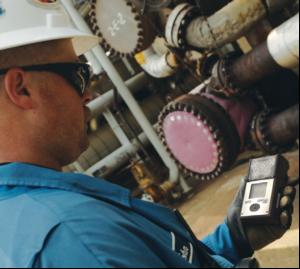The challenges faced by users of portable gas detection
equipment remain similar but the way in which the end user
is meeting these challenges is changing says Colin Anderson
There is now a broader
understanding of gaThe challenges faced by users of portable gas detection
equipment remain similar but the way in which the end user
is meeting these challenges is changing says Colin Anderson
There is now a broader
understanding of gas detection
technology within user groups.
Whether the users are working for a
refinery or a waste water plant, the
understanding and appreciation of gas
detection technology has increased over
recent years enabling safer working
environments.
Companies such as Industrial Scientific
have been instrumental in leading this
change in understanding and education.
Users now understand the significance of
carrying out daily functional "bump" tests.
This is becoming the industry norm, and
customers are implementing gas detection
systems which allow them to incorporate
daily "bump" testing as standard.
In our experience many gas detection
end users are no longer satisfied with
sending instruments away for calibration.
They are now opting for systems which
allow for on-site, fully automated
instrument calibration on a regular basis.
Given that they now have a better
understanding of the sensor technology,
they fully appreciate, and are implementing
calibrations on a monthly basis.
Similarly, it is expected that their fleet
of instruments are always fully
operational. Operational "up time" must
be maximised, and end users know that
systems are available which will ensure a
fully operational gas detector fleet all of
the time.
Sending instruments away for
maintenance is becoming a thing of the
past, as users opt for fully automated
remote maintenance systems. Similarly,
precious technician time can no longer be
spent maintaining gas detectors. Instead it
needs to be focussed on the core business
of the company. This has resulted in a
wave of change, with a movement
towards gas detection as a service.
Gas detection as a service
Gas detection as a service is instrumental
in driving change within the U.K. and
global markets. The continued focus on
operator safety and education has
increased the understanding of gas
detection, leading to safer working
environments.
With the increased understanding and
appreciation of gas detection technology
comes a desire for data. This data is a
record of the environment that each gas
detector sees every day. Companies now
see how useful and powerful this data is to
their operations. Therefore there is a
hunger within end user companies to be
able to gather, harness and use this data to
enhance site safety. End users are now
seeing that the gathered data can easily be
compiled and presented automatically,
and as a result, they are opting for gas
detection systems which can present the
data in a simple, yet comprehensive way.
This data is then easily analysed to further
enhance site safety. With the
implementation of gas detection as a
service, this data analysis is no longer a
cumbersome task. Instead, it is a matter of
course, or a default activity, which
automatically enhances safety.
As you can see, there is a clear change
within the market. Many end users no
longer see the gas detector as a simple
hazard alarm. They see gas detection as a
full safety service, which can be remotely
managed for them, and can provide
valuable data to enable them to
proactively improve process and safety on
site.
Industrial Scientific has driven this
change in the market, through iNet - its
gas detection as a service solution.
These are exciting changes within the
industry; they are empowering the end
user to create a safer working
environment, whilst allowing them to
concentrate on their core business.
Colin Anderson is the area manager for
Industrial Scientific.


